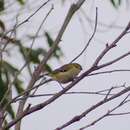Biology
provided by Arkive
The forty-spotted pardalote forages almost exclusively in the foliage of white gum trees, hence its dependency on this eucalypt's availability (2). It feeds by gleaning invertebrates, from the relatively large leaves of the white gum, as well as lerp, a protective coat secreted by sap sucking insects, and manna, a sugary substance secreted by eucalypts in response to insect attack (2) (3) (4).
A territorial bird, the forty-spotted pardalote tends to nest in loose colonies at permanent sites, with breeding pairs probably staying together for several years (3). At the beginning of the breeding season, which extends from August through to December, nests are built in the hollows of tree trunks and branches as well as dead stumps and fallen logs (3) (5). Between four to five eggs are laid and incubated for a period of 16 to 20 days. On hatching the chicks are reared almost exclusively on the carbohydrate and sugar-rich lerp and manna. Most chicks fledge between September and October, around 25 days after hatching, but some breeding pairs will produce a second clutch that fledges later. During the non-breeding season, there is restricted local dispersal by both adults and juveniles, probably in response to the limited availability of food around the colonies over winter (3).
Conservation
provided by Arkive
The preservation of white gum woodlands and forests is critical to the survival of the forty-spotted pardalote (3). Fortunately, around 60 percent of the habitat currently occupied is protected within reserves, including the most significant breeding colony on Bruny Island (2). A recovery plan, which ran from 1991 to 1997, was instrumental in increasing the amount of protected habitat, as well as in locating new colonies, planting white gum seedlings to create new habitat, and raising public awareness. The current stability of the forty-pardalote population, at around 3,800 birds in 2008, is evidence of the success of the original recovery plan, but because it still has a very small and fragmented range, the species remains classified as Endangered on the IUCN Red List (1) (2) (3). A new four-year recovery plan, implemented in 2006, has the central aim of improving the conservation status of the forty-spotted pardalote sufficiently to warrant it being down-listed to Vulnerable. In order to achieve this, the plan intends to enhance and expand existing habitat, to assist in the colonisation of potential habitat and to conduct research that will help to identify and respond to threats restricting the current population (3).
Description
provided by Arkive
The rare and endangered forty-spotted pardalote is a small, delicate bird with numerous distinct white dots arranged in rows on the tips of its black wing feathers (2) (4). Its body is generally olive green, sullied grey over the breast and belly, with pale yellow around the eyes and rump (2) (3) (4). The sexes have the same plumage but the males produce a diagnostic mating call during the breeding season (3). While broadly similar in appearance and habit to the much more common and widespread striated and spotted pardalotes, the forty-spotted pardalote has a duller body and lacks their distinctive head markings (4) (3).
Habitat
provided by Arkive
This bird occurs in dry woodlands and forests where white gum (Eucalyptus viminalis) is a significant component of the canopy (2) (3).
Range
provided by Arkive
The forty-spotted pardalote is endemic to Tasmania, Australia, where it is restricted to a small number of islands and peninsulas along the east coast (3). Ninety percent of the population occur on Maria and Bruny Island with smaller remnant colonies on Flinders Island and Tinderbox Peninsula, Howden and Mount Nelson near Hobart (2).
Status
provided by Arkive
Classified as Endangered (EN) on the IUCN Red List (1).
Threats
provided by Arkive
The decline in white gum woodlands and forests, as a result of historical land clearance for agriculture, forestry and urban development, is chiefly responsible for the reduced number and highly fragmented populations that occur today (2) (3). Since European colonisation, over 50 percent of white gum forest in the south east region of Tasmania has been cleared, and on private land, clearing still continues. The impact of woodland fragmentation on the forty-spotted pardalote is particularly damaging as the bird is not capable of long-distance dispersal, and thus colonies quickly become isolated from each other (3). Wildfires, which kill canopy trees and restrict regeneration of young trees, pose an additional threat and it is feared that fires that swept through Flinders Island in 2002 may have severely damaged the remaining colonies found there (2) (3). Aside from habitat loss, there is concern that aggressive birds, such as the noisy miner (Manorina melanocephala), are invading forty-spotted pardalote habitat where it has been opened up by disturbance and clearance, and subsequently are outcompeting this species for resources (3).

